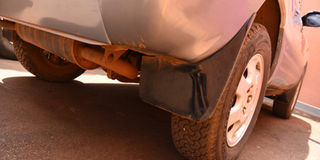Why your car tyres are making that noise

Wider tyres normally generate more noise than their narrower counterparts because there is more rubber in contact with the road. PHOTO | ALEX ESAGALA
The only source of noise you expect to hear while driving mostly comes from the environment within which you are driving. However, some of it may come from your car, especially from the tyres.
Poor alignment
According to Hamza Massadda, a wheel alignment technician, poor tyre alignment is one of the reasons your tyres could be making noise. Mechanically, car tyres have to move forward as you steer regardless of whether you are driving on a straight stretch or negotiating a corner.
Massadda says when you start hearing tyre noise, it means that instead of moving forward, one or more of your tyres are moving in the opposite direction.
“If you mistakenly release the steering upon hearing such sounds, you will notice the car is facing another direction as if it is getting off the road,” he says.
Uneven tyre wear
According to Massadda, tyre wear manifests in a number of ways. First, it could manifest when the inner tyre tread area dissolves faster than the outer one, when the wheels are not aligned or when one side of the tread area is wearing out faster than the other. This is mostly caused by driving habits such as braking instantly.
“Because you cannot buy treads separately and attach them to the worn out area, it will cause uneven tyre wear and the noises will persist and intensify until you have the affected one replaced,” Massadda explains.
Low profile tyres
Peter Amadi, a mechanic, says low profile tyres have a smaller body, mainly tubeless in nature and are used on bigger or wider rims. Because the tyre is around a wider rim, the way you hit a pothole or hump is the same way you will feel the discomfort and the tyre noise it comes with.
“You may think your suspension system is weak or old but the problem comes from the low profile tyres. The smaller the tyre profile, the more noise you will hear as you drive and the bigger the tyre size, the less noise you will hear,” Amadi says.
“If you do not want to hear this irritating tyre noise, buy high profile tyres and scale down to low profile rims,” he advises.
Besides producing tyre noises, Amadi says low profile tyres are not only expensive but they also compromise fuel economy than normal tyres.
Non-uniform tyres
Abubaker Kasozi, a spare parts dealer, argues that every car comes with the right tyre size while some car brands are manufactured and ought to use specific tyre brands depending on the manufacturer’s prescriptions. Because some motorists like to experiment, you may end up having different tyre brands.
According to Kasozi, it is not only important to stick to the same tyre size and brand but it is equally important to put the same amounts of tyre pressure when you visit the pressure pump at your local station.
Wide tyres
According to Skaidon, an online portal, wider tyres normally generate more noise than their narrower counterparts because there is more rubber in contact with the road. The portal says a simple equation to remember is that more rubber equals more traction but it also equals more noise.
“If you have recently changed your tyres and start hearing a noise from it, you should not worry as this is normal,” the portal advises.
Most tyres noises will be heard when your car windows are lowered as opposed to when they are raised. Lowering your windows does not only help you understand which particular tyre or tyres produce the noise but it also helps you hear any other noises your car makes.
This also helps you determine your next course of mechanical action before you get involved in any accidents.
Avoiding tyre wear
The best way to keep tyre wear to a minimum is to maintain correct tyre pressure for the load and speed conditions, and to drive as smoothly and carefully as possible. Avoid fierce braking, hard cornering and violent acceleration.
Fierce braking and acceleration scrub rubber off the tyre treads until a bare flat patch is worn. Brake flats may also result from faulty brakes that lock the wheel.
A distorted drum - distorted by the heat from excessive braking - may cause flats on opposite sides of the same tyre because a high spot on each side of the drum catches and drags the shoes.
Hard cornering transfers much of the car weight to the outside wheels, increasing the load on their tyres, particularly the tread shoulders. Even a slight increase in cornering speed can increase tread wear significantly.
Although wear increases with higher speeds, motorway cruising causes less wear to tyres than journeys with more braking and acceleration.
Poor road surfaces accelerate tyre wear, so does the weather. Tyres wear quicker in extremes of heat or cold. Wet roads cool the tyres and reduce friction between the tread and the road, so wear is lessened.
Uneven tyre wear indicates that something is wrong with the car. It may simply be that the tyres are not properly inflated, or there may be faults in the braking, steering or suspension systems .
The fault may be dangerous, and should be remedied as soon as possible. Although the cure may be expensive, in the long run it may be cheaper than continually replacing worn tyres.
(Source: howacarworks.com)




